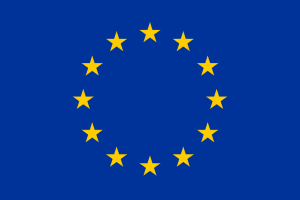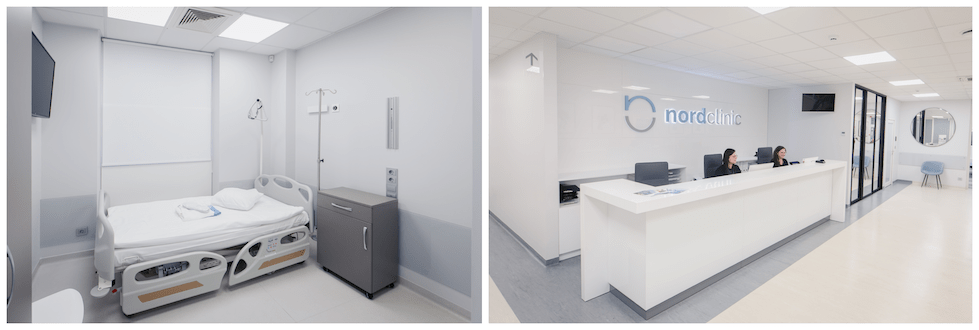Gallbladder Removal Abroad: Lithuania
Leading medical tourism clinic
We are the leading medical tourism clinic in the Baltic region with over 10 years of experience. We are proud of the fact that around 90% of our patients come from abroad: the UK, Ireland and Scandinavian countries – this is the area we specialise in and our processes have been adapted to cater specifically for patients from abroad. Our team of surgeons perform over 4.000 surgeries per year, mostly plastic, bariatric, orthopaedic, general and gynecological surgeries.
Reviews and Facebook group
Our patients and clinic in the media
Prices
- Gallbladder removal surgery – 2.170 £ (from 920 £ with S2 funding*)
*Your surgery can be partly funded via the S2 funding route (read more in the next tab)
- accommodation with medical care – from 62 £ per night
The S2 route may entitle you to NHS funding for planned state healthcare treatment in Lithuania. You can save up to 50% for the gallbladder surgery. Contact our customer service for more information:
- Gallbladder removal surgery
- 2.170 £ without S2 funding
- from 920 £ with S2 funding
Get your surgery for free by claiming a refund from your local health board. We cooperate with HSE and other health boards across the EU to help our Irish and EU patients receive a refund for their weight loss surgery in Lithuania. The clinic helps with the documents needed to claim a refund after following the EU directive route for medical treatment abroad.
- consultation with the surgeon and anaesthesiologist
- all the necessary health tests before and after the surgery
- surgery
- anaesthesia
- hospital stay (1-3 days) with 24 hours medical care
- 24/7 personal assistance during your stay
Please note that the price of the surgery itself is provisional and may be accurately assessed only after the evaluation of each individual case.
The default currency at our clinic is EUR, so if you were looking at prices in GBP it may vary depending on GBP / EUR exchange rate at the moment of payment.
- Gallbladder removal surgery – 2.600 € (from 1.100 € with S2 funding*)
*Your surgery can be partly funded via the S2 funding route (read more in the next tab)
- accommodation with medical care – from 74 € per night
The S2 route may entitle you to NHS funding for planned state healthcare treatment in Lithuania. You can save up to 50% for the gallbladder surgery. Contact our customer service for more information:
- Gallbladder removal surgery
- 2.600 € without S2 funding
- from 1.100 € with S2 funding
Get your surgery for free by claiming a refund from your local health board. We cooperate with HSE and other health boards across the EU to help our Irish and EU patients receive a refund for their weight loss surgery in Lithuania. The clinic helps with the documents needed to claim a refund after following the EU directive route for medical treatment abroad.
- consultation with the surgeon and anaesthesiologist
- all the necessary health tests before and after the surgery
- surgery
- anaesthesia
- hospital stay (1-3 days) with 24 hours medical care
- 24/7 personal assistance during your stay
Please note that the price of the surgery itself is provisional and may be accurately assessed only after the evaluation of each individual case.
The default currency at our clinic is EUR, so if you were looking at prices in GBP it may vary depending on GBP / EUR exchange rate at the moment of payment.
Patient stories
Refund for EU patients

Get your surgery for free by claiming a refund from your local health board. The clinic helps patients with the documents needed to claim a refund after following the EU directive route for medical treatment abroad. It applies to patients who are insured under the systems of one of the EU countries and may not get the surgery due to long waiting times. On average our patients from the EU countries get fully refunded by their local health board in 3-5 months after their surgeries.
Our surgeon
- Our surgeon Linas Venclauskas with over 15 years’ of experience
- Specialises in minimally invasive surgery, surgical treatment of the upper gastrointestinal tract and bariatric surgery
- Associate Professor at Lithuanian University of Health Sciences
- President of the Kaunas Society of Surgeons
- A member of the European Hernia Society
- Chairman of the Lithuanian Society of Hernia Surgery
11 reasons that make us the most popular bariatric clinic abroad
Our team of 3 bariatric surgeons has 15-20 years of experience in the field in total performing over 500 different bariatric surgeries per year. Moreover, our surgeons are members of various prestigious surgical societies both Lithuanian and international. Our leading bariatric surgeon Dr Almantas Maleckas has performed more than 7.000 bariatric surgeries. He is fluent in four languages, among which English and Swedish. The surgeon has been regularly working in Sweden for over 15 years. Dr Maleckas is a pioneer of laparoscopic surgery in Eastern Europe and has trained many other bariatric surgeons in the region.
We are one of the leading bariatric surgery clinics for medical tourists in the European Union. We are proud of the fact that over 90 % of our patients come from the UK, Ireland, Norway, Sweden, Denmark, Germany, Switzerland and other countries.
We are trusted by our patients and we appreciate all the reviews and feedback collected over the years. Find testimonials here or on Google.
Already more than 5.000 of our former, current and future patients joined our online community with the aim to build a space for opinions and mutual support. Members are welcome to share experiences about their visit to the clinic and to discuss all surgery-related matters.
We offer a 5-year follow-up which includes being able to get in touch with our Lithuanian dietitian Karolina. She is consulting patients after surgery and is available upon request to answer postoperative nutritional questions for five years after surgery.
Our clinic is the only clinic that has developed its own app designed specifically for bariatric patients – Bariatric IQ. The most useful feature of this app is special bariatric diet recommendations based on a particular product, a patient’s gender, time after surgery and other factors. Such a feature has not been replicated by any other bariatric apps in the world. Read more and download the app on your IOS or Android smartphone here.
Our clinic works according to the highest standards set by the European Union. This helps to guarantee the quality of medical services. We care about the safety, comfort and successful results of our patients from all over the world.
The clinic helps patients with the documents needed to claim a refund after following the EU directive route for medical treatment abroad. It applies to patients who are insured under the systems of one of the EU countries and may not get the surgery due to long waiting times.
We provide customer service in 9 foreign languages including English, Swedish, Norwegian, Danish, Italian, Spanish, French, Russian, Polish. Everyone in our clinic speaks English, including nurses, assistants and the surgeon.
Combining different plastic surgery procedures to offer optimal treatment for post-bariatric patients has been our plastic surgery department’s specialisation for many years now. We have performed such surgeries for more than 10.000 patients to this date. Since weight loss patients often require multiple surgical procedures to address excess skin, surgery planning and surgeons’ experience are very important. We carefully select patients, evaluate each case individually, and only agree to combine surgeries within health & safety limits. Our team of 9 plastic surgeons performs more than 3.000 plastic operations a year, a number that no other clinic in Central & Eastern Europe can match.
Direct flights to Lithuania







What is cholecystectomy, or gallbladder removal surgery?
Laparoscopic cholecystectomy is the gold standard technique for treating gallbladder diseases in both acute and elective surgery, when gallbladder, a pear-shaped sac situated on the inferior surface of the liver, is removed. Anatomically gallbladder is divided into fundus, body and neck, which is linked to the bile ducts. Its main function is to store and collect bile which plays an important role in fat digestion and absorption, and serves as a means for excreting several important waste products from blood, such as bilirubin, an end product of hemoglobin destruction, and cholesterol excess. Gallbladder removal surgery is commonly performed when there is an inflammation present inside the gallbladder causing moderate to severe pain and directly affecting the quality of a patient’s life.
When is gallbladder removal necessary?
Laparoscopic cholecystectomy is indicated for patients with symptomatic gallbladder disease who can tolerate general anesthesia, including patients with calcified gallbladder. Gallbladder diseases refer to a great variety of medical conditions that affect gallbladder, and are usually associated with some particular physical symptoms. Some of widely prevailed symptoms among potential cholecystectomy patients are:
- Biliary colic, also known as gallbladder attack, which is defined as episodes of severe intermittent peaks of pain in the upper middle or right part of the abdomen, and last from a few minutes to several hours.
- Jaundice, which is yellowing of the skin and sclera from accumulation of yellow bile pigment bilirubin in the blood and tissues.
- Nausea and vomiting.
- Palpable tenderness in the upper right abdominal area.
All of these distinct symptoms are usually provoked by the presence of gallstones inside the gallbladder. As gallstones pass through the bile ducts, they obstruct the tubes that carry bile from liver to gallbladder and further into the small intestine. Any blockage in the biliary system results in stasis of bile and may cause acute or chronic inflammation of the gallbladder, better known as cholecystitis. The management of symptomatic acute or chronic cholecystitis requires surgical removal of the gallbladder. Moreover, gallstone pancreatitis, better known as inflammation of pancreas, may be severe and accompanied by serious complications but its recurrences are prevented by cholecystectomy.
In order to precisely determine the necessity for surgery, an ultrasound examination of the gallbladder is used as the initial diagnostic procedure because in addition to sludge and stones, it can also detect tenderness over the gallbladder. As ultrasound examination does not give accurate information on the exact site of the abdomen, further investigation with computed tomography or magnetic resonance imaging is required.
How is the surgery performed?
Laparoscopic gallbladder surgery, also known as “keyhole surgery”, is facilitated by inflating peritoneal cavity with CO2, a noncombustible gas. Although CO2 is systemically absorbed during the procedure, the advantages of reduced postoperative pain far outweigh any potentially deleterious effects of temporarily elevated levels of CO2 in the blood. A single camera port and a number of operating ports are placed, through which the specially designed instruments are used to manipulate the intra abdominal contents. This way only a few tiny cuts are needed for a gallbladder to be successfully removed.
As successful as a standard 4-port laparoscopic cholecystectomy is, a great variety of alternatives and improvements have been applied in clinical practice so far. The most prevalent alternative surgical techniques include robotic-assisted cholecystectomy, mini-laparoscopic cholecystectomy (which differs from a standard laparoscopic gallbladder removal only in size of surgical instruments), single-incision laparoscopic cholecystectomy and natural orifice cholecystectomy (during which the abdominal cavity is accessed through natural openings of a body, e. g. anal canal).
What preparation is needed for this surgery?
A proper preparation for cholecystectomy does not differ significantly from preparations for any other intermediate or low surgical risk procedure. However, when acute inflammation is present, the surgery may be postponed until clinically relevant symptoms, such as fever, fatigue etc. are stabilized with intravenous fluids and antibiotics.
Here are some major recommendations that should be taken into account in order to reduce risk of perioperative complications and speed up the recovery:
If cholecystectomy is scheduled in advance, a patient should be encouraged to maintain a healthy lifestyle before the procedure. Having one‘s diet balanced and staying hydrated strengthen the body and the immune system. However, when gallstones are present even mild exercises can provoke biliary colic due to stones moving inside the bile ducts.
Tobacco products and alcohol should be avoided for as long as possible before the procedure. Chemical compounds inhaled with smoke contribute to clot forming processes inside the blood stream, which deteriorates tissue perfusion with oxygen. Moreover, alcohol consumption damages liver and so the symptoms of pre-existing gallbladder disease may worsen.
In order to prevent perioperative complications, taking aspirin, anti-inflammatory drugs and other blood thinners should be avoided before the procedure, unless the operating doctor has advised differently.
In order to properly assess the surgery risk and plan the prophylactic treatment of comorbid conditions, which might complicate or adversely affect the procedure it is vitally important to inform the doctors about your allergies, previous surgeries and pre-existing conditions that require daily usage of drugs.
Recovery after gallbladder removal surgery (what to expect?)
General recovery after cholecystectomy usually takes about 1-3 weeks.
The duration of post-op hospitalisation depends entirely on the patient’s health status. The patient may even be discharged the same day after the surgery if no complications are present.
A patient can usually return to work 1 week after the surgery, if the operating doctor has not advised differently.
It is advised not to soak in a bathtub until the stitches or staples are removed and the incision sites are healed. One may take a shower the day after the procedure if not advised differently by the doctor.
Patients are strongly discouraged from consuming alcohol and using tobacco products, especially while taking any kind of prescribed drugs after the surgery, for they may provoke some toxic side effects and complications could develop.
Life without the gallbladder
There are many misconceptions and myths about life after gallbladder removal surgery. Truth to be told, it is not as complicated as many people imagine. Gallbladder is a sac to store substances that are produced by liver, and may later be used for food to be digested in the small intestine. Once the gallbladder is removed, bile cannot be stored and so digestion of fatty foods may become a bit more complicated, as there is only a certain amount of bile that may be excreted into the intestines at a time. For this reason, in the first few weeks after the surgery it is advised to gradually add more diverse foods back into one’s diet and skip high-fat foods in order for the gastrointestinal tract to comfortably adjust to the changes. Later on these recommendations may vary depending on one’s personal state of health.
Common myths about gallbladder removal surgery
As significant as gallbladder is, it does not play a vitally important role in the process of food digestion. Therefore, after a total gallbladder removal our body is able to function just as well as in its presence. Here are some widely spread myths and facts about what happens when gallbladder is removed:
Our clinic

Self-catered accommodation with medical care
Send us your enquiry








